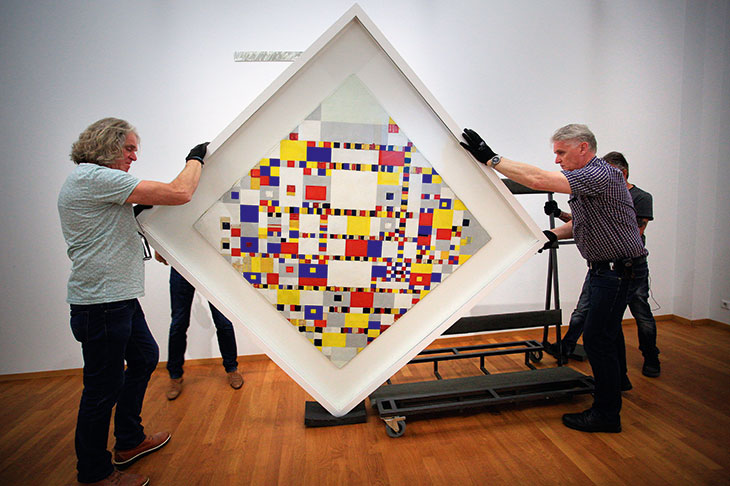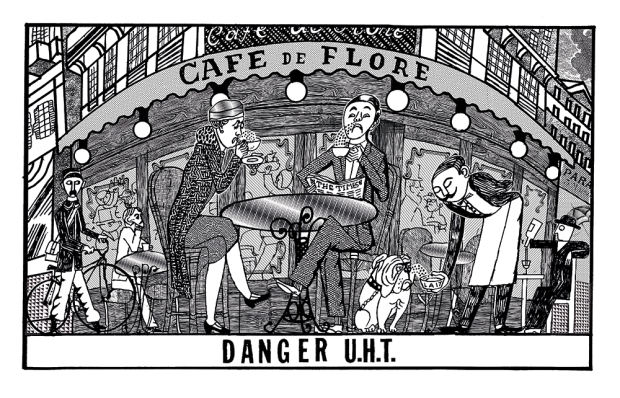It starts as soon as I arrive. In Den Haag Centraal railway station, the kiosks, windows, lift shaft, piano and even the hoarding on the building site outside, are all cheerfully decked out in red, blue and yellow rectangles, black lines and an occasional patch of straight-sided white. Holland’s capital has gone Mondrian mad; the style of De Stijl (the modernist art movement to whichF he belonged) is plastered all over town, indeed over much of the country. Holland is in the grip of ‘Mondrian to Dutch Design: 100 Years of De Stijl’, a year celebrating its ‘most important contribution to the 20th century’.
De Stijl’s influence is everywhere. It has influenced (and disrupted) the Bauhaus, modernism and the International Style in architecture; it’s visible in today’s colour blocking, visible construction, open-plan living.
‘The Style’ was born in October 1917 as a magazine in the lovely university town of Leiden. It was midwifed by painter, architect and artistic agitator Theo van Doesburg. Celebrated this summer in an open-air exhibition of geometric art outside Leiden’s 900-year-old Pieterskerk, this was a bloodless October revolution. De Stijl reacted to the first world war by promoting an abstract aesthetic for what was felt as well as what was seen; it aimed to put art into everything and usher in a better future. In The Hague’s Gemeentemuseum home of this year’s flagship Mondrian exhibition, the permanent collection includes Francis Bacon and a mobile of noose-hung animals by Bruce Nauman. Important though these are, they make me appreciate Mondrian all the more. In the museum’s comprehensive overview of his work, we see him from his earliest windmills and canal-reflected trees to his famous ‘balanced’ asymmetric geometric compositions, always offering not horror, but hope.
In Eindhoven, today’s capital of Dutch design (which hosts another of the year’s many De Stijl exhibitions), I sit over coffee with the programme director of Dutch Design Week. He explains that this 2,500-designer-event in October is ‘about design fiction (as in science fiction) as well as finished products’. ‘Like De Stijl,’ he adds, ‘we are looking into the future’ — positively.
Mondrian has long been assumed to have been a rigid geometrician. He was certainly serious about his art (in his Paris studio he covered his books in white so they would not disturb the aesthetic), but recent research has shown him to have been a lover of music, dance and women, as well as all things new, including Disney cartoons. And, seen in the original, his paintings aren’t rigid either. Indeed Rothko wrote he was, ‘one of the greatest sensualists who ever lived’.
Hans Janssen, Mondrian’s latest biographer, is standing in the final room of the Gemeentemuseum exhibition, looking admiringly at the artist’s last painting. Having been labelled degenerate by the Nazis, Mondrian moved to London. Mid-Blitz he set sail for New York and watched as the ship ahead of his was torpedoed. Yet in 1944, as he was dying of lung disease, Mondrian painted ‘his most modern, vibrant painting’: ‘Victory Boogie-Woogie’. ‘It’s about unity,’ says Janssen. ‘He was an optimist.’
The Mondrian exhibition opened on 3 June. That night came the terrorist attack on London Bridge. As I left Holland for home the next morning, I determined to carry with me a bit of De Stijl’s colourful optimism and Mondrian’s ‘Boogie-Woogie’.
Got something to add? Join the discussion and comment below.
Get 10 issues for just $10
Subscribe to The Spectator Australia today for the next 10 magazine issues, plus full online access, for just $10.
You might disagree with half of it, but you’ll enjoy reading all of it. Try your first month for free, then just $2 a week for the remainder of your first year.














Comments
Don't miss out
Join the conversation with other Spectator Australia readers. Subscribe to leave a comment.
SUBSCRIBEAlready a subscriber? Log in